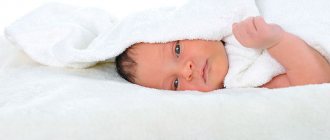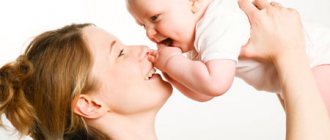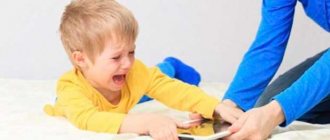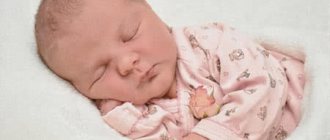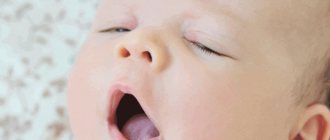How do babies gain weight?
The gynecology staff on duty panicked. In the evening, they gave birth to a “filling” - an abortion was performed on a woman at 26 weeks for social reasons. The silent fetus was wrapped in a diaper and laid out outside the window - no need to run to the morgue at night? The failed mother left immediately after the abortion - she had five years of age waiting at home. And suddenly, in the dark, dark silence, crying was heard outside the window. Plaintive, squeaky. The nurse and orderly, crossing themselves, approached the window - the bundle was moving...
I won’t bore you, I’ll tell you the continuation of the story right away. Nature has endowed newborn children with unprecedented vitality. The cold forced the baby to take his first breath and scream. With trembling hands, the nurse took out the package, unwrapped it and placed it on the changing table.
The baby squeaked, moved his thin arms and legs, and weighed only 800 grams. Women in white coats looked at this miracle as if spellbound.
But the “miracle” stopped moving, screaming and breathing. Sighing, the nurse wrapped him in a diaper again and put him out the window. It was night. I didn't want to sleep. The women listened intently and suddenly... yes, yes, again - a squeak! Here the pediatrician on duty was already called, who began to cast a spell on the baby, who did not want to leave this world. The child survived. And when he was 4 months old and gained 2.5 kg, his mother suddenly came running. She lived on a distant farm and rumors about the “surviving flood” did not reach her immediately. She hugged me, pressed her to her chest, and cried. She said that she decided to have an abortion under the influence of stress - her husband lost his job, and she already had a lot of children. I couldn’t forgive myself for this weakness later, I prayed. In general, this story has a good ending. “Baby” is now many years old and he, the only one of all the children in the family, graduated from college, returned to his native place as an agronomist and helps his parents a lot. This story is also unique in that the extremely premature baby survived without an incubator or a neonatologist.
Which babies are considered premature
Today, a baby born from 22 to 37 weeks of pregnancy is considered premature. There is such a thing as a live birth criterion. Russia switched to the criteria approved by the World Health Organization in 2012.
According to these parameters, a premature newborn baby is an infant from 500 grams and 25 centimeters, born from the 22nd week of gestation. If a baby with such indicators survives, he is registered and nursed. Every year, 5-10% of such children are born in the world out of the total number of newborns. Prematurity of a child in the modern world is not a death sentence, since today there are all conditions for caring for “early” children.
Features of care
Caring for a premature baby has a number of features:
- Cloth . It should be made of natural materials, with snap fasteners, so that medical devices can be easily secured.
- Care products. Must be hypoallergenic and selected depending on the degree of prematurity of the child. The skin of a premature baby is very delicate and sensitive. In the hospital department and later at home you will need diapers for premature babies. They come in “zero” sizes up to 1 kg, and from 1 to 3 kg.
- Temperature regime. The air temperature in the room should be 23-24 degrees, around the child’s body - approximately 28 degrees. If necessary, you can use heating pads. Optimal air humidity is 70%. This temperature regime must be maintained throughout the first month.
- Bathing. There should be no sudden temperature changes. To avoid this, you need to wrap the baby in a thin diaper, place it in the bathtub, unfold the cloth and wash the baby. The temperature in the room should be at least 25 degrees, water - at least 36 degrees. You need to wrap the baby in a warm towel. It is better if both parents bathe the child.
- Walks. The child must be protected from hypothermia and sudden changes in temperature. If the baby was born in the summer and his body weight is more than 2 kg, then you can go for a walk right away. Walks last a maximum of a quarter of an hour, the air temperature outside should be 25 degrees. If the baby was born in spring or autumn, then walking is allowed at 1.5 months, when he weighs 2.5 kg. When a child is born in winter, going outside is allowed with a body weight of 3 kg and an air temperature of a maximum of -10 degrees.
- Massage and physical education. All premature babies need them. It is advisable if they are done by a specialist. Physical education and massage normalize the musculoskeletal system, improve metabolism and digestion. With their help, the child will sit up, stand up, crawl and walk on time.
Degrees of prematurity
There are four degrees:
- First degree - birth occurs at 36-37 weeks of pregnancy. The child weighs 2001-2500 grams at birth, his height is 41-45 centimeters;
- Second degree - birth at 32-35 weeks of gestation, the child’s body weight at birth is 1501-2000 grams, height is 36-40 centimeters;
- Third degree - birth at 28-31 weeks, the weight of the newborn is 1001-1500 grams, height - 30-35 centimeters;
- Fourth degree - birth occurs before 28 weeks of gestation. At birth, the baby weighs less than a kilogram and its body length is less than 30 centimeters. These newborns are called “extremely low birth weight preterm.”
Premature babies: consequences
However, it is not at all necessary that all the difficulties listed above will affect the child. In addition, competent medical supervision and parental care work wonders. Many cope with all difficulties and continue to live fully.
Prematurity is not always a story of illness and weakness. Thus, it is known that such celebrities as the artist Leonardo da Vinci, the emperor and commander Napoleon Bonaparte, the scientist Albert Einstein and one of the founders of classical physics Isaac Newton were born prematurely.
Premature babies: development
The development of such a newborn certainly has its own characteristics. But, in most cases, after a while these children “catch up” with their full-term peers in development and in the future are no different from them.
Natalya Zotkina, founder and director of the Right to Miracle charity foundation for premature babies:
— About 80% of “early” children catch up with their peers in development by the age of 2-3 years. However, 20% of babies are at risk for various diseases. My daughter was born at 27 weeks weighing 1 kilogram and she has cerebral palsy. She studies in a regular school along with everyone else, although she uses a wheelchair. At the same time, I know children with the same weight and born at the same stage, who are in excellent health and have no pathologies. Everything is very individual. Our foundation always emphasizes: every story is unique. You cannot compare one premature baby to another.
What can he do? or developing the skills of a premature baby.
Very often parents of premature babies ask me - what will happen to him next? Relatives and friends add fuel to the fire by telling scary stories about profound mental retardation and severe disability of such children. But this is not true - extreme prematurity does not mean at all that the child will become disabled or develop abnormally. Of course, they are different, different requirements are placed on them, but this does not mean that such children are defective. To dispel doubts, let’s talk about the peculiarities of the development of skills of premature babies, their neuropsychic development and the characteristics that you, parents, need to know. What is their difference? Basic skills and age-related abilities (holding the head, crawling, sitting, standing, and others) appear in most premature babies at a later date than in full-term babies. Premature babies later begin to focus on visual and auditory stimuli, later hold their heads, later begin to walk, smile, recognize surrounding faces, laugh, roll over, sit, stand, walk, purposefully move their arms, and speak. The lag in psychomotor development depends on how premature the baby is. If the baby is born after 32 weeks, the baby’s skills will develop later by about 1-1.5 months; if born before 30-31 weeks, they will all slow down by about 3-4 months. By the end of the first year of life, most children with short periods of prematurity catch up with their peers, and by 2-3 years, very premature babies born weighing 500 grams or even less are compared with them. In children who are ill for a long time, children with developmental defects or in the absence of necessary care, the lag in neuropsychic development is more pronounced. To monitor the neuropsychological development of a premature baby, especially with a body weight of up to 2500 g, special indicators of the neuropsychological development of premature children in the first year of life are used. Typically, all values are indicated in comparison with age for full-term babies and the limits of fluctuations are indicated when a new sign may appear in a premature baby, depending on body weight at birth. what we can? I will dwell in more detail on the exact timing of the appearance of skills, so that it will be easier for you to navigate whether there is a problem or everything is fine with you. A delay of more than a month behind the established deadlines will be considered abnormal. A baby with a body weight of less than 1500 grams fixes his gaze, smiles for the first time, makes attempts to hold his head while lying on his stomach at the age of 2-4 months; children weighing 1500-1700 grams master these same skills in 2-3 months, with a weight of 1701-2000 grams - at the age of 1-2.5 months, and babies 2000-2500 grams - at 1-2 months of age. The baby tries to follow and listen to you, quickly answers you with a smile - with a body weight of less than 1500 grams at the age of 4-6 months, children with a weight of 1500-1700 grams master these same skills in 3.5-4.5 months, with a weight of 1701-2000 grams - at the age of 3-5 months, and babies 2000-2500 grams - at 2-3 months of age. Your baby concentrates visually, listens, perks up when you appear, accidentally bumps into a toy hanging over his chest, holds his head well and focuses his gaze on the adult, being held in his arms in a vertical position, rests his legs, and begins to walk. These skills are formed with a body weight of less than 1500 grams at the age of 4-6.5 months, children with a weight of 1500-1700 grams master these same skills in 4-6 months, with a weight of 1701-2000 grams - at the age of 4-5 months, and babies 2000-2500 grams - at 3-4 months of life. A child finds an invisible source of sound, laughs loudly, grabs a suspended toy, gurgles - with a body weight of less than 1500 grams at the age of 6 months, children with a weight of 1500-1700 grams master these same skills in 5-6 months, with a weight of 1701-2000 grams - at the age of 5-6 months, and babies 2000-2500 grams - at 4.5 months of age. Your baby can distinguish the tone of speech addressed to him, distinguish strangers from loved ones, clearly take a toy from the hands of adults, can turn on his stomach, stand steadily with support, and walk for a long time. This is acquired with a body weight of less than 1500 grams at the age of 6.5-7.5 months; children weighing 1500-1700 grams master these same skills in 6-7 months, with a weight of 1701-2000 grams - at the age of 6-6.5 months, and babies 2000-2500 grams - at 5.5-6 months of life. The baby can freely take toys from different positions, can roll over from his stomach to his back, crawl, begins to babble, can eat from a spoon and remove food with his lips - with a body weight of less than 1500 grams at the age of 7.5-8.5 months, the same skills are children weighing 1500 -1700 grams are mastered at 7-8 months, with a weight of 1701-2000 grams - at the age of 6.5-7 months, and babies 2000-2500 grams - at 6-7 months of age. The baby has learned to crawl well, babbles for a long time, when asked “Where?”, finds an object located in the same place - with a body weight of less than 1500 grams at the age of 9-11 months, children weighing 1500-1700 grams master these same skills 8.5-10 months, with a weight of 1701-2000 grams - at the age of 8-9 months, and babies 2000-2500 grams - at 7.5-8.5 months of life. The child plays with toys for a long time, sits down and stands up, holding onto the barrier, steps over, pronounces syllables loudly and repeatedly, says “okay”, “give me a pen”, “goodbye”, eats bread himself, pours from a cup held by an adult - when body weight less than 1500 grams at the age of 9.5-12 months, children with a weight of 1500-1700 grams master these same skills at 9.5-12 months, with a weight of 1701-2000 grams - at the age of 9-10 months, and babies 2000-2500 gram - at 8.5-10 months of life. Acts with objects in different ways: rolls, takes out, walks, slightly holding on, repeats various syllables after adults, knows his name when asked “where?”, finds an object in different places, shows the skill of neatness - with a body weight of less than 1500 grams per at the age of 11.5-13 months, children with a weight of 1500-1700 grams master these same skills at 11-12 months, with a weight of 1701-2000 grams - at the age of 10.5-11 months, and babies with a weight of 2000-2500 grams - at 8.5-10 months of life . The baby opens, puts in a toy, climbs onto a high surface and gets off it, at the request of “give”, gives familiar objects - with a body weight of less than 1500 grams at the age of 12.5-14 months, children weighing 1500-1700 grams master these same skills at 12-12 months. 13 months, with a weight of 1701-2000 grams - at the age of 11.5-12 months, and babies 2000-2500 grams - at 10-11 months of life. The baby places cubes, removes the ring from the pyramid with a large hole, stands independently, uses the first symbols: aw-aw, kitty-kis - with a body weight of less than 1500 grams at the age of 13.5-14.5 months, the same skills are children weighing 1500- 1700 grams are mastered at 11.5-12.5 months, with a weight of 1701-2000 grams - at the age of 11-12 months, and babies 2000-2500 grams - at 11-12 months of life. Begins to walk independently, has a vocabulary of about 10 simple words, upon request performs actions: shake Lala, where are the eyes, etc. - the baby acquires these skills with a body weight of less than 1500 grams at the age of 14-16 months, the same skills are children weighing 1500-1700 grams are mastered at 12-15 months, with a weight of 1701-2000 grams - at the age of 12-13 months, and babies 2000-2500 grams - at 13-13 months of age. How do you know when there are problems? When assessing the development of a premature baby, the actual level of development is compared, what he can confidently do from the proposed skills today, and this is compared with the normative indicators at a given age. This is how the child’s individual rate of maturation is determined (slow, normal, accelerated, mosaic). Problems are considered to be a slowdown in skill development for 1-2 months, and for more than 2-3 skill lines. Of course, it is absolutely wrong to level a baby. who was born at term with a baby who was born weighing less than a kilogram - they will be very different in development. But in order to know the basic patterns and be able to understand in time that something is going wrong, doctors are developing many schemes for assessing the development of a child’s skills. His abilities are assessed, making sure to adjust for the degree of prematurity. That is, how many weeks will he rush into the world, this is usually 40 weeks minus the due date. With age, the level of mental development of a premature baby changes and approaches the normal level, as a result of which maintaining the initial correction loses its meaning, and to assess the level of development at the age of 12-14 months, focusing on the standards for ordinary healthy full-term babies becomes optimal. If developmental problems arise - or you are concerned about the lack of a particular skill, do not hesitate - contact your pediatrician or neurologist. The doctor will evaluate the baby using a special in-depth scale and will say for sure whether the baby has problems or not. Then treatment, if necessary, will be correct and timely. what difficulties might there be? Psychological rehabilitation of a premature infant is usually based, first of all, on warm emotional contacts and a favorable mode of obtaining auditory and motor experience, creating a feeling of psychological comfort and helping the child cope with the effects of external and internal stress. You need to talk to them, carry them in your arms, pressing them to your stomach, do gymnastics, developmental techniques, and walk a lot. This is especially important for very premature babies, because in the first years of life such children are noticeably behind the norm. Unfortunately, it happens that prematurity is accompanied by damage to the nervous tissue, which can cause some consequences. The lower the birth weight, the more significant the impairment. Most intellectual disabilities last a lifetime. In all cases, the initial manifestations of mental disorders concern the vegetative-instinctive sphere, sensory development (sense organs), motor skills, emotional sphere, communication sphere, cognitive development, social behavior and the formation of prototypes of self-awareness. In the structure of mental disorders at an early age in premature infants, the most common are behavioral and emotional disorders, disorders of psychological development and organic mental disorders. Among behavioral and emotional deviations in children, pathological habitual actions in the form of nail biting, finger sucking and pacifiers predominate. Organic mental disorders (epilepsy, seizures) are much less common in such children. Behavioral and character defects in prematurely born children in preschool age are the most common reason for parents turning to a psychiatrist. In preschoolers, these are disorders of appetite, sleep, sleepwalking, pathological habits, emotional lability, fears, and disruption of adaptation in a team. However, this does not mean at all that your child will be like this - work started on time leads to full development and the baby will grow up healthy. You just need more strength, perseverance and patience in studying and developing abilities, and you will need more careful care for your child. Children born very prematurely have a fairly low level of development in childhood. Speech and sensory development especially suffers; in older age, thinking, attention, and memory suffer. Only 35% of children who are premature are ready to enter school, 9% are not ready, the rest are conditionally ready. The main psychological signs in these children are anxiety, insecurity, difficulties in communication, conflict, and hostility. What will these kids need? The first is your love, affection, care and attention - this is 90% of success in treatment, nursing and full development. The rest is the help of doctors - pediatrician, neurologist, psychologist, other specialists, if necessary. Medicine has made great strides forward - we can help babies weighing half a kilo, but!!!! Only a mother’s love works miracles, it lifts hopelessly sick people out of bed, it inspires faith and hope that everything will be fine. Love your baby, tell him about your love, cry and laugh together, always be present and your baby will grow up to be a strong and healthy boy or girl!
Development of premature babies by month
Only children born prematurely , as a rule, need special conditions and constant supervision by doctors. Often these babies are fed through a feeding tube and their breathing is supported through artificial oxygen.
A premature baby is one month old: at this time he may completely lack innate reflexes. During this period, the baby gains very little weight.
In the second month, such children already begin to gain weight, but they are still very weak: they get tired quickly and mostly sleep. In the third month, the baby already acquires reflexes, reactions to sound and even facial expressions.
By 6 months , the child, in a good situation, increases weight approximately three times. By this time, babies with the first degree may no longer be any different from their peers born at term.
Premature babies: development up to one year
By the age of one year, children, as a rule, have already completely “evened out” in development - both physical and psycho-emotional. The development of a premature baby largely depends on the care and responsible attitude of parents to the recommendations of doctors.
Born prematurely: what does a premature baby look like?
Of course, a premature baby is different in appearance from a full-term baby, but much depends on the gestational age.
The main external distinctive signs of premature babies
Moderate prematurity: I-II degree
* Muscle tone is somewhat reduced, but the baby is generally active. * The skin is pink and the subcutaneous fat layer is moderately thin. * Vellus hair (lanugo) is absent from the skin on the face from 32-33 weeks, and starting from 35-37 weeks - usually on the entire surface of the skin. * The nipples and peripapillary areas (the skin around the nipples) are clearly visible and pigmented (colored). * The first bends in the ears appear at 35-37 weeks. * Usually the physique is proportional: the size of the head and the length of the limbs (arms, legs) relative to the body are of normal size. * The navel is located closer to the center of the abdomen, but still slightly lower than in full-term babies. * Nails typically extend to the edges of the toes (nail bed). * The external genitalia are well developed. In girls, the genital slit is almost closed. In boys, the testicles are located at the entrance to the scrotum (in the upper third), but sometimes there is unilateral cryptorchidism (one testicle does not descend into the scrotum).
Deep prematurity: III-IV degree
* Due to decreased muscle tone, the child lies with his arms and legs extended. * The skin is dark red, thin and wrinkled (like an old man’s), often swollen, and abundantly covered with vellus hair. * The subcutaneous fat layer is thinned. * The baby has a somewhat disproportionate physique: the size of the head is large in relation to the length of the body, and the limbs are short compared to the body. * The navel is located in the lower third of the abdomen. * The nipples and parapapillary areas are poorly pigmented and difficult to see. * The ears are soft, have no convolutions and are shapeless, pressed to the head and located low. * Baby's nails are underdeveloped and usually do not reach the fingertips. * The cranial sutures are open, the small, large and lateral fontanelles are large, and the bones of the skull are soft. * External genitalia are underdeveloped. In girls, the labia majora do not cover the labia minora, so the genital slit is gaping (open). In boys, the testicles usually have not yet descended into the scrotum.
However, it should be remembered that the same baby does not always show all the signs of prematurity equally clearly and clearly in accordance with the gestational age. It often happens that some of them are more pronounced and others less.
Stages of nursing premature babies
The first stage of nursing is care and supervision by medical staff in the maternity hospital. Large perinatal centers have a special intensive care unit for such newborns. At this stage, it is important that the baby does not become hypothermic, so doctors touch him only with warm hands, wrap him in heated diapers, and even the changing table is preheated.
The second stage is nursing the baby in the pathology department of the hospital. In modern departments, mothers can stay with their children. The child is weighed every day, height and head circumference are measured. As soon as the newborn reaches the desired two kilograms in weight, he is discharged home. If there are any deviations in health, the baby is left in the pathology department until complete recovery.
And finally, stage three : observation at home. The doctor and nurse at the children's clinic must examine the child on the first day after discharge. Then doctors will periodically visit the baby, monitor his condition and development and give recommendations for care to parents. Humidity is about 70%, a comfortable temperature of 20-22C, ventilation of the room, water for bathing heated to approximately 39C: premature babies require all this. The stages of nursing include, first of all, medical control and a special, attentive attitude of mom and dad to the child.
Respiratory system of a premature baby
In premature babies, the respiratory rate usually exceeds the norm and depends on the degree of prematurity: the lower the child’s body weight, the more frequently he breathes.
Due to the immaturity of the nervous system, as well as the lipid metabolism system, the derivative of which is surfactant, which ensures the opening of the lungs during the first breath and their normal functioning in the future, premature infants often develop respiratory distress syndrome
, which is manifested by the development of atelectasis. Atelectasis are areas of collapsed or incompletely straightened lung tissue that do not participate in breathing and can cause respiratory failure. Such a child is transferred to artificial ventilation until the respiratory system begins to function on its own. Against the background of respiratory distress syndrome, various infectious diseases (pneumonia) often occur, which certainly worsens the child’s condition. To avoid such complications, if premature birth is predicted (hemolytic disease of the fetus, severe forms of gestosis, etc.), the woman is given special glucocorticoid drugs during pregnancy, which accelerate the maturation of the fetal respiratory system.
After the baby is discharged from the maternity hospital or children's hospital, in order to reduce the likelihood of inflammatory diseases of the respiratory system, you should try to protect him from a large number of contacts with potentially infected relatives and friends, limiting his circle of contacts only to family members. To maintain a normal microclimate, you should ventilate the room where the baby is, while, however, not forgetting about the temperature regime.
Nursing premature babies
Caring for a premature baby in a maternity hospital usually begins with placing the baby in a special “incubator” with a given temperature and humidity. Here the baby grows up in conditions as close as possible to those in the womb. He is weighed daily. Parents can talk to the baby and hold his hand, and later, when he gets stronger, pick him up and hold him close. It has been proven that this has a positive effect on the neuropsychic development of the child.
After the premature baby has gained vital grams, doctors can finally discharge him and his mother home.
It is also important to maintain proper child care at home. Parents are recommended to carry out special gymnastics and massage for the baby. Massage at this stage, as a rule, is an important component of care: you can resort to the services of a professional, but it is better for the specialist to come to you himself, and all manipulations take place in the usual home conditions. The immunity of early children is very weak at first, so it’s worth being safe.
The newborn should be placed on his stomach: this will strengthen his muscles in the back of the head, limbs, abdomen and back. It is important to harden the baby: give him “air baths” and bathe him every day, but the water temperature should not be lower than 37 degrees.
The nutrition of a premature baby should not be based on the principle: the more the baby eats, the better, because he will gain weight faster. At the same time, overfeeding such children is a common mistake of parents. The digestive system of early babies is not well developed, as is the sucking reflex, which is important for the child. Therefore, it is better to feed more often, but in small portions, so as not to overload digestion. The best nutrition for a baby born prematurely is mother's milk. But, if for some reason natural feeding is not possible, the doctor will help the parents select a special artificial formula.
Caring for premature babies at home
A premature baby has a number of characteristics and requires special conditions for its full development. Such conditions can be created without much difficulty at home, you just need to follow a few recommendations.
Firstly, caring for premature babies involves temperature control.
For a premature baby, optimal temperature conditions must be created at home. The air temperature should be 22-25 degrees Celsius. Ventilation of the premises should be carried out every three hours for fifteen to twenty minutes. Near the child, directly under the blanket with which he is covered, the temperature should be maintained at twenty-eight to thirty-two degrees Celsius. Often, especially in the winter, there is a need for additional heating of a newborn. To do this, it is convenient to use rubber heating pads with hot (60-65 degrees) water. It should be remembered that electrical appliances should not be used to heat the baby. Depending on the degree of prematurity and temperature conditions in the room, you can use from 1 to 3 heating pads. The heating pads are wrapped in fabric (towels, diapers or special bags) and placed under the blanket at the feet and on top of the blanket on the sides at a distance of an adult’s palm from the child. To constantly monitor the temperature and for convenience in general, you can place a thermometer next to the child.
It is important not to place heating pads under the child to avoid burns and place her on top, as this will make breathing difficult. You also need to change the heating pads alternately every one and a half to two hours and make sure that the child is not left without heating even for short periods of time. The newborn's face should always be exposed.
By the end of the first month, the baby will begin to “maintain” body temperature on his own, and, as a result, it will be possible to completely abandon artificial heating. The child's body temperature should be measured twice a day, morning and evening, unless, of course, the doctor gives other instructions. Body temperature is measured without undressing the baby.
Clothes for premature babies
A baby born weighing over two kilograms does not need to be wrapped. He is dressed in the same way as full-term babies. Children who weigh less than two kilograms need a lot more things. The most optimal clothing is for premature babies, which consists of elements such as knitted caps, knitted blouses with a hood and sewn sleeves, rompers and diapers. A child dressed in this way should be wrapped in a flannelette blanket, placed in a woolen envelope and covered with a flannel blanket on top. By the end of the first month, you should gradually abandon the blanket and envelope. It should be remembered that tight swaddling restricts the baby’s breathing, which is strictly contraindicated. To ensure uniform breathing by all parts of the newborn’s lungs, it is necessary to regularly turn the baby from one side to the other.
Bathing a premature baby
Babies whose birth weight was less than one and a half kilograms should not be bathed in the first two to three weeks of being at home. Children whose birth weight was above 1500 grams are allowed to bathe after 7-10 days. In the first three months of a child’s life, bathing is carried out in boiled water. The temperature in the room where bathing is performed should be twenty-five degrees Celsius, and the water temperature should be 38 C.
Nutrition of premature babies. Feeding methods
• Breast-feeding.
• Feeding premature babies using tubes using infusion pumps.
• Portioned feeding using a tube (food is administered with a syringe)
• Mixed or artificial feeding, using special formulas for premature babies.
Feeding premature babies
When children are able to feed on their mother’s breasts on their own, they should be provided with the most comfortable feeding of premature babies.
• The baby often has difficulty keeping the nipple in his mouth. In this case, the most effective position of the baby in your arms will be the “under the arm” or “cradle” position, when the child is located along the forearm, and the mother’s hand supports the child by the shoulders.
• If a child swallows air, then it is worth taking a reclining position, for example, placing several pillows under his back.
• To help the baby hold the nipple, you can use the so-called “dancer’s hand” method, which involves the mother supporting the baby’s cheeks and chin.
Walks
You should be careful while walking, as sudden changes in temperature can adversely affect the baby's health. Premature babies who were born with a body weight of more than one and a half kilograms are allowed to be taken for walks from the age of two weeks at an air temperature outside the window of 25-26 degrees Celsius. The first walk should not be long, only ten to fifteen minutes, then the duration can be increased each time by 10-20 minutes, thereby bringing it to one to one and a half hours. In the autumn and spring seasons, at temperatures below ten degrees Celsius, it is allowed to walk with infants over one month old and weighing over two and a half kilograms. If the air temperature is below eight degrees, walks with children are allowed when they reach the age of two months and body weight over 2800 grams.


